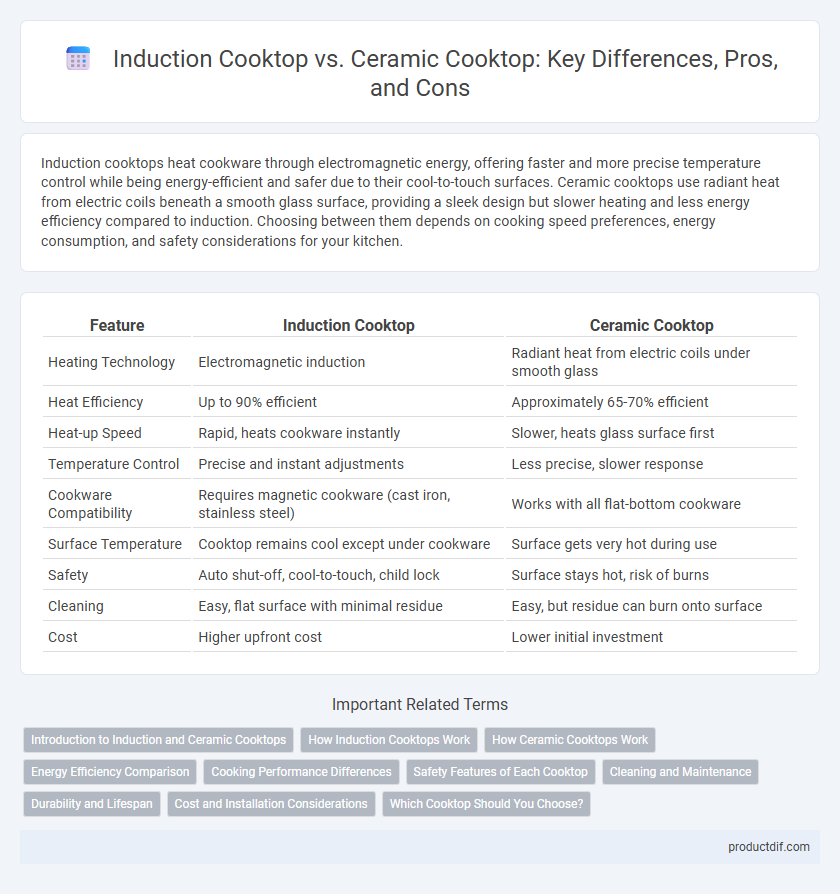Induction cooktops heat cookware through electromagnetic energy, offering faster and more precise temperature control while being energy-efficient and safer due to their cool-to-touch surfaces. Ceramic cooktops use radiant heat from electric coils beneath a smooth glass surface, providing a sleek design but slower heating and less energy efficiency compared to induction. Choosing between them depends on cooking speed preferences, energy consumption, and safety considerations for your kitchen.
Table of Comparison
| Feature | Induction Cooktop | Ceramic Cooktop |
|---|---|---|
| Heating Technology | Electromagnetic induction | Radiant heat from electric coils under smooth glass |
| Heat Efficiency | Up to 90% efficient | Approximately 65-70% efficient |
| Heat-up Speed | Rapid, heats cookware instantly | Slower, heats glass surface first |
| Temperature Control | Precise and instant adjustments | Less precise, slower response |
| Cookware Compatibility | Requires magnetic cookware (cast iron, stainless steel) | Works with all flat-bottom cookware |
| Surface Temperature | Cooktop remains cool except under cookware | Surface gets very hot during use |
| Safety | Auto shut-off, cool-to-touch, child lock | Surface stays hot, risk of burns |
| Cleaning | Easy, flat surface with minimal residue | Easy, but residue can burn onto surface |
| Cost | Higher upfront cost | Lower initial investment |
Introduction to Induction and Ceramic Cooktops
Induction cooktops use electromagnetic fields to directly heat pots and pans, offering rapid temperature control and energy efficiency. Ceramic cooktops utilize radiant heating elements beneath a smooth glass surface, providing even heat distribution and a sleek design. Both appliances cater to modern kitchens but differ significantly in heating technology and performance.
How Induction Cooktops Work
Induction cooktops use electromagnetic fields to directly heat pots and pans, providing rapid and precise temperature control compared to ceramic cooktops that rely on radiant heat from electric coils beneath a glass surface. The induction process requires cookware made of ferromagnetic material such as cast iron or stainless steel for efficient energy transfer. This method ensures faster heating, improved energy efficiency, and enhanced safety by keeping the cooktop surface relatively cool during operation.
How Ceramic Cooktops Work
Ceramic cooktops use radiant heat generated by electric heating elements beneath a smooth glass-ceramic surface to cook food evenly and efficiently. The glass-ceramic material is durable and heat-resistant, allowing for rapid heat transfer while remaining cool to the touch around the cooking zones. This technology ensures consistent temperature control and easy cleaning compared to traditional coil stovetops.
Energy Efficiency Comparison
Induction cooktops convert approximately 90% of energy directly to the cookware, making them significantly more energy-efficient than ceramic cooktops, which typically transfer around 65-70% of energy due to heat loss on the glass surface. The rapid heating technology in induction cooktops reduces cooking time and energy consumption, contributing to lower electricity bills and a smaller environmental footprint. Ceramic cooktops, while visually appealing, tend to consume more energy as they rely on electric resistance beneath the glass that heats the surface before transferring heat to the pot, resulting in greater energy waste.
Cooking Performance Differences
Induction cooktops offer precise temperature control and rapid heat-up times due to electromagnetic technology, providing efficient and consistent cooking performance. Ceramic cooktops rely on radiant heat elements beneath a smooth glass surface, which results in slower heat response and less accurate temperature regulation. The overall cooking precision and energy efficiency of induction models surpass ceramic cooktops, making them ideal for tasks requiring exact heat settings.
Safety Features of Each Cooktop
Induction cooktops incorporate advanced safety features such as automatic shut-off when no pan is detected and surface cooling that minimizes burn risks, making them safer for households with children. Ceramic cooktops use radiant heat and often include residual heat indicators to alert users when the surface is still hot, reducing accidental burns. Both cooktop types offer built-in safety mechanisms, but induction technology provides more precise heat control and faster cool-down times, enhancing overall kitchen safety.
Cleaning and Maintenance
Induction cooktops feature a smooth glass surface that resists spills and burns, making cleaning effortless with just a damp cloth and mild detergent. Ceramic cooktops also have a glass-ceramic surface but are more prone to stubborn stains and require specialized cleaners to prevent scratching. Regular maintenance for induction models involves minimal effort, while ceramic cooktops often demand careful cleaning to avoid damage and maintain their appearance.
Durability and Lifespan
Induction cooktops typically offer greater durability and longer lifespan compared to ceramic cooktops due to their solid-state design and lack of exposed heating elements. Ceramic cooktops, while sleek, are prone to scratches, cracks, and can suffer from heat-related wear over time, reducing their overall lifespan. Choosing an induction cooktop can mean fewer repairs and replacement needs, making it a more reliable appliance for long-term kitchen use.
Cost and Installation Considerations
Induction cooktops generally have a higher upfront cost compared to ceramic cooktops, with prices ranging from $300 to $1,500 depending on the brand and features. Installation for induction cooktops often requires compatible cookware and dedicated electrical wiring, potentially increasing installation expenses. Ceramic cooktops tend to be more affordable, typically priced between $200 and $1,000, and have simpler installation processes since they operate on standard electric circuits.
Which Cooktop Should You Choose?
Induction cooktops offer faster heating and greater energy efficiency by using electromagnetic fields to directly heat cookware, making them ideal for precise temperature control and safety. Ceramic cooktops provide a smooth, aesthetically pleasing surface with compatible cookware and are generally more affordable but heat slower and retain residual heat longer. Choose an induction cooktop for efficiency and safety, while ceramic cooktops are preferable for budget-conscious users seeking a sleek design.
Induction Cooktop vs Ceramic Cooktop Infographic

 productdif.com
productdif.com